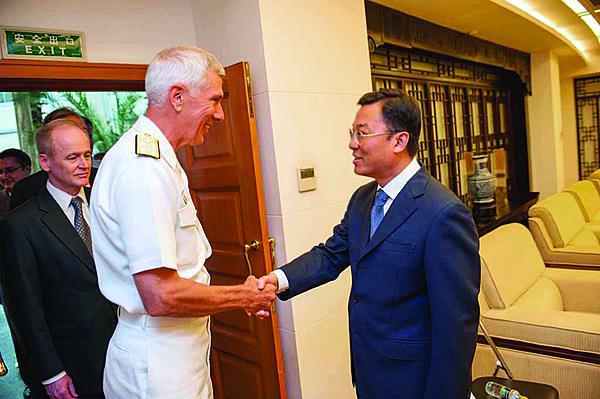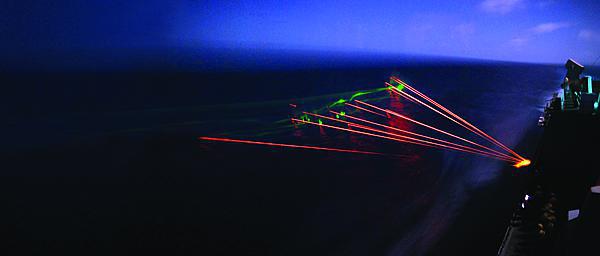Pacific Command Adjusts to New Regional Emphasis
The new U.S. strategic thrust toward the Asia-Pacific region is boosting longtime efforts in both coalition building and force projection. Bilateral alliances are evolving into multinational operations, and U.S. forces are increasing their forward deployed presence in quantity and capability.
Existing efforts are ramped up to achieve bigger results sooner.
The new U.S. strategic thrust toward the Asia-Pacific region is boosting longtime efforts in both coalition building and force projection. Bilateral alliances are evolving into multinational operations, and U.S. forces are increasing their forward deployed presence in quantity and capability.
Because the United States is viewed as a guarantor of security by dozens of nations in that vast area, it is able to bring together countries that historically have viewed each other with distrust. Building around a core of five allies, the U.S. Pacific Command (PACOM) is extending its security synergy across the breadth of countries that span an area comprising more than half the Earth’s surface. Coupled with that effort is a redeployment of U.S. forces from the mainland and Southwest Asia to traditional and new locations where they can be ready to deal with a host of contingencies.
The new U.S. defense strategy announced in January 2012 features a rebalancing of U.S. strategic goals to include a greater focus on the Asia-Pacific region. The United States has been a Pacific nation since 1850, and the rebalancing is viewed as an acknowledgement of the growing importance of that region to U.S. economic and geopolitical interests. While this represents a whole-of-government approach, it includes a significant military element.
Adm. Samuel J. Locklear III, USN, PACOM commander, notes that the strategy calls for PACOM to strengthen historic alliances as well as to pursue a long-term strategic partnership with India. It also must continue to grow its relationship with China as the Asian giant emerges as a regional and eventually global superpower. And, the United States must be properly positioned for whatever may happen with North Korea, which the admiral hopes will entail a peaceful and stable situation.
The admiral allows that challenges will emerge as the command deals with uncertain budgetary conditions. However, he believes that PACOM will be able to have a better and more significant influence in the Asia-Pacific security environment throughout the coming decade.
As U.S. forces withdraw from Southwest Asia, some of those resources will be reallocated to the Asia-Pacific region “in a more definitive way,” Adm. Locklear says. In particular, U.S. Army and Marine Corps forces that have been largely absent from the PACOM area of operations will be returning to the region. Large numbers of the 3 Marine Expeditionary Force (MEF) are returning to Japan, and the 1 MEF has been aligned to the Asia-Pacific region. Also, some Marines may be placed on a rotational basis in Australia.
The Army may be aligned on a rotational model that places more Army forces forward in more places to build partnerships among nations. Adm. Locklear notes that I Corps has been realigned, coming out of Southwest Asia, to be in the Pacific. This gives PACOM a significant surge and response capability, the admiral adds. The Army also is likely to consider pre-positioning more equipment for missions ranging from humanitarian assistance to local operations relevant to the host nation.
The Navy will be upgrading its Pacific forces through replacement. Older ships will be replaced by high-end ships with more capabilities, the admiral says. Some Navy ships will be rotated through Singapore, and ongoing plans call for deploying submarines into Guam.
The U.S. Air Force also will be biasing more high-end capabilities in the Asia-Pacific region, Adm. Locklear continues. These assets include F-22 fighter aircraft and bomber forces that will ensure that U.S. bases are “survivable and available for any contingency that might arise,” he states.
The PACOM presence in Australia builds on a long-standing relationship, the admiral observes. The increase in exercises with the two nations “is more a recognition of the expanding security imperatives” of the region. The complexity of the security environment has grown more toward the south—the Straits of Malacca and the Indian Ocean—so the United States and Australia are increasing their partnership to be better prepared for the increasing number of issues that may come to the fore.
This added emphasis toward Australia “is a recognition that [Australia] has a perspective of the security environment, particularly in its area, and it has a leadership role to play as we move forward,” Adm. Locklear states. “We’re interested in bringing them into a more trilateral [relationship] with Japan and the United States.”
Despite the rebalancing, the command’s challenges largely remain unchanged. The admiral notes that, given the size of the theater, the lines of communication that allow forward operations are long and increasingly rely on cyber and space. The longest-term challenge may be to enable PACOM to stay forward in a meaningful way, he offers.
The command long has been active in setting up partnerships and coalitions when necessary, and its increased emphasis similarly is increasing the importance of its relationships with those other nations. “The future is bright with our allies here and with our emerging partners,” Adm. Locklear states. “We’ve made good progress in better positioning ourselves for disasters” as well as for other potential mission areas.
The longtime strategy for relationships with Asia-Pacific nations has been a hub-and-spoke model, the admiral notes. However, as the governments and economies of these nations have changed, so has their own outreach beyond their borders. Their militaries have grown in sophistication and capabilities, which in turn has encouraged historically distrustful countries to come together in multilateral forums. Adm. Locklear relates that the United States has helped these overcome some of these issues so that they can engage in greater information sharing and build more trust and confidence. The emphasis is on areas where these nations agree, rather than their differences, he says, adding that they share many common concerns. “They all want to defend their own homelands; they all have counterterrorism concerns; they all are worried about illicit trafficking and transnational crime; they all want to protect their maritime and information [assets], along with their fisheries and their oil and mineral rights. And, in the end, they all have concerns for each other as it relates to national disasters.”
Citing the devastating earthquakes, tsunamis and powerful typhoons that have wreaked havoc throughout the region in recent years, the admiral points out that natural disasters could destabilize the environment in the region. It is in the interest of all nations in the Asia-Pacific region to come together to deal with those contingencies. Multinational exercises are helping bring those nations together, as the number of participants increases yearly. Adm. Locklear offers that these military-to-military exercises are one of the best ways for nations to move past their political animosities.
The dominant Asian power in the region is China, and the United States continues to strive to build a relationship with the economic and geopolitical power. Adm. Locklear describes this effort as a coordinated whole-of-government approach, not just a military focus. He has visited Beijing and spoken with his counterparts in the People’s Liberation Army (PLA), and PACOM is seeking to bring the PLA more into the multilateral forums that the command sponsors. “We’re looking at opportunities to do that where it makes sense where their [China’s] national interest and ours align,” he explains. “We’re trying to focus on where we have things in common.
“I’m hopeful that our emerging relationship with China will be a positive one, because that is in the best interest of the global security environment at large as well as [for] regional issues here,” he emphasizes.
China and Japan recently have been at odds over the Senkaku/Diaoyu Islands, with each nation claiming sovereignty. Adm. Locklear notes that the official U.S. policy is to take no sides over territorial disputes, and he says it “very much makes sense” by encouraging the parties to resolve their disagreement peacefully without coercion and under international law. The United States is engaged in “a fair amount of dialogue at all levels” with China and U.S. allies to resolve the issue. The admiral notes that both China and Japan are keeping this sovereignty dispute “in the law enforcement and fisheries lane” rather than elevating it into the military realm.
If PACOM’s theaterwide efforts are successful, its five alliances—Australia, Japan, the Republic of Korea, the Philippines and Thailand—will be stronger in that they will be adapted for the 21st century and are forward looking, the admiral says. In addition, the United States will see a strategic relationship with India emerge. The dynamic scenario on the Korean peninsula will be manageable to the extent of a peaceful, secure outcome. And, the relationship with China will lead to the Middle Kingdom becoming a productive part of the Asia-Pacific security environment.
As with all the U.S. military commands, PACOM’s ability to meet its challenges will be influenced by budget issues. The looming cuts mandated by the sequestration, if allowed to occur, will have a significant effect. Adm. Locklear notes that each war fought by the United States was followed by a drawdown in defense spending, and that effect was expected with the end of U.S. combat in Afghanistan and Iraq. The issue is how to shape the force to suit its funding, and where must the force assume risk as it is shaped.
“When you get into sequestration, all of us have said—and that includes the secretary of defense—that it would be pretty devastating because of the way it would be implemented,” the admiral declares. “But, as PACOM commander, I would have to assess the risk that we have to assume in the near term as the sequestration takes effect. We’ll have to do that at the time the [sequestration] decision is made.
“Our ability as a military to maintain our role as a global power will be impacted—we’ll have to reassess our global strategy,” he continues, adding that he cannot yet determine how those cuts would affect PACOM.






Comments